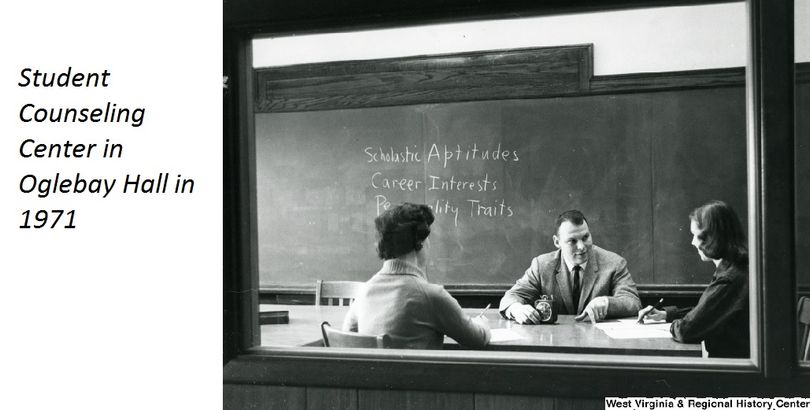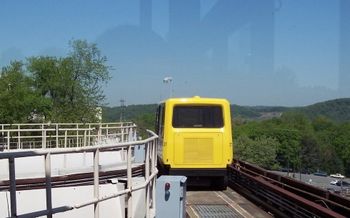Psychology faculty and students were not the only ones experiencing problems associated
with limited space. The entire university was experiencing the space crunch on its
50-acre campus adjacent to downtown Morgantown and had to search for acceptable land
for expansion. Fortunately, the University had acquired farm land north of town in
1948 and envisioned two new campuses on those sites, one for professional schools
of engineering and agricultural sciences (now the Evansdale Campus) and the other
for a medical center (now the Health Sciences Center Campus). The vision became reality
in 1961 with the Schools of Agriculture and Engineering relocating from the downtown
campus to their new buildings on the Evansdale Campus. Because of the space needs
of the Department of Philosophy and Psychology, the Department moved from Woodburn
Hall into Oglebay Hall in 1962, a building that had been in use by the College of
Agriculture since 1918 when it was constructed. The mast from the USS West Virginia,
a battleship badly damaged at Pearl Harbor but rebuilt to assist in bringing World
War II to a close, was erected in Oglebay Plaza as the department moved into its
new facility.
During this period of re-organization at WVU, separate Departments of Psychology and Philosophy were formed within the College of Arts and Sciences. With this step, the Department of Psychology occupied most of Oglebay Hall, with the exceptions being the ice cream shop maintained by the WVU Dairy and a baking laboratory of the home economics program. The former provided a venue for students to get a sweet treat in between classes and the latter enabled psychology faculty and students to experience wonderful aromas of bread well into the 1980s when the ovens were removed.
Continued construction on the Evansdale Campus resulted in completion of a building to house the newly formed College of Human Resources and Education in 1969. This unit included programs previously housed in the College of Education, home economics, that was previously housed in the College of Agriculture, and social work, that was housed in the College of Arts and Sciences. Based on overlapping interests in learning, assessment, and applied clinical and counseling work, there was some discussion at that time of relocating psychology to this new professional college on the Evansdale Campus. After all, the applied psychology faculty had been collaborating with social work faculty in training rehabilitation counselors since the 1950s. However, although the facilities on the new campus were modern and attractive, the Department of Psychology opted to remain in Oglebay Hall in the College of Arts and Sciences. The location provided easy access for students seeking assistance from psychology faculty and staff in the Student Counseling Center housed on the third floor of Oglebay Hall.

From its inception, clinical psychology services were desired in the Department of Behavioral Medicine and Psychiatry at the Medical Center when it opened in the early 1960s. Recipient of a master’s degree in psychology from WVU, Eugene A. Quarrick, PhD, returned to Morgantown following completion of doctoral work from Syracuse University in 1963. Although appointed as a member of the faculty of the new Department of Psychology, he spent most of his career at WVU engaged in provision of clinical services as a psychologist in the Department of Behavioral Medicine and Psychiatry.
 It was not until the next decade when the three campuses were connected by the Personal
Rapid Transit (PRT), a transportation system constructed as a demonstration project
for the US Department of Transportation.
It was not until the next decade when the three campuses were connected by the Personal
Rapid Transit (PRT), a transportation system constructed as a demonstration project
for the US Department of Transportation.
< History HOME NEXT History Page >
During this period of re-organization at WVU, separate Departments of Psychology and Philosophy were formed within the College of Arts and Sciences. With this step, the Department of Psychology occupied most of Oglebay Hall, with the exceptions being the ice cream shop maintained by the WVU Dairy and a baking laboratory of the home economics program. The former provided a venue for students to get a sweet treat in between classes and the latter enabled psychology faculty and students to experience wonderful aromas of bread well into the 1980s when the ovens were removed.
Continued construction on the Evansdale Campus resulted in completion of a building to house the newly formed College of Human Resources and Education in 1969. This unit included programs previously housed in the College of Education, home economics, that was previously housed in the College of Agriculture, and social work, that was housed in the College of Arts and Sciences. Based on overlapping interests in learning, assessment, and applied clinical and counseling work, there was some discussion at that time of relocating psychology to this new professional college on the Evansdale Campus. After all, the applied psychology faculty had been collaborating with social work faculty in training rehabilitation counselors since the 1950s. However, although the facilities on the new campus were modern and attractive, the Department of Psychology opted to remain in Oglebay Hall in the College of Arts and Sciences. The location provided easy access for students seeking assistance from psychology faculty and staff in the Student Counseling Center housed on the third floor of Oglebay Hall.
From its inception, clinical psychology services were desired in the Department of Behavioral Medicine and Psychiatry at the Medical Center when it opened in the early 1960s. Recipient of a master’s degree in psychology from WVU, Eugene A. Quarrick, PhD, returned to Morgantown following completion of doctoral work from Syracuse University in 1963. Although appointed as a member of the faculty of the new Department of Psychology, he spent most of his career at WVU engaged in provision of clinical services as a psychologist in the Department of Behavioral Medicine and Psychiatry.
< History HOME NEXT History Page >